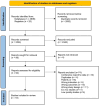Cannabinoids in Integumentary Wound Care: A Systematic Review of Emerging Preclinical and Clinical Evidence
- PMID: 39204426
- PMCID: PMC11359183
- DOI: 10.3390/pharmaceutics16081081
Cannabinoids in Integumentary Wound Care: A Systematic Review of Emerging Preclinical and Clinical Evidence
Abstract
This systematic review critically evaluates preclinical and clinical data on the antibacterial and wound healing properties of cannabinoids in integument wounds. Comprehensive searches were conducted across multiple databases, including CINAHL, Cochrane library, Medline, Embase, PubMed, Web of Science, and LILACS, encompassing records up to May 22, 2024. Eighteen studies met the inclusion criteria. Eleven were animal studies, predominantly utilizing murine models (n = 10) and one equine model, involving 437 animals. The seven human studies ranged from case reports to randomized controlled trials, encompassing 92 participants aged six months to ninety years, with sample sizes varying from 1 to 69 patients. The studies examined the effects of various cannabinoid formulations, including combinations with other plant extracts, crude extracts, and purified and synthetic cannabis-based medications administered topically, intraperitoneally, orally, or sublingually. Four animal and three human studies reported complete wound closure. Hemp fruit oil extract, cannabidiol (CBD), and GP1a resulted in complete wound closure in twenty-three (range: 5-84) days with a healing rate of 66-86% within ten days in animal studies. One human study documented a wound healing rate of 3.3 cm2 over 30 days, while three studies on chronic, non-healing wounds reported an average healing time of 54 (21-150) days for 17 patients by oral oils with tetrahydrocannabinol (THC) and CBD and topical gels with THC, CBD, and terpenes. CBD and tetrahydrocannabidiol demonstrated significant potential in reducing bacterial loads in murine models. However, further high-quality research is imperative to fully elucidate the therapeutic potential of cannabinoids in the treatment of bacterial skin infections and wounds. Additionally, it is crucial to delineate the impact of medicinal cannabis on the various phases of wound healing. This study was registered in PROSPERO (CRD42021255413).
Keywords: antibacterial; antimicrobial resistance; cannabinoids; medicinal cannabis; wound healing.
Conflict of interest statement
Justin Sinclair (J.S.) is a recipient of the Western Sydney University Post-graduate research scholarship and is employed by the Australian Natural Therapeutics Group. J.S. also sits on the board of the Australian Medicinal Cannabis Association, and the advisory boards of Cannabis Clinicians Australia and United in Compassion, all in a pro bono capacity. Vincent Maida (V.M.) is the Chief Medical Scientist for Kensana Health Inc. He has developed cannabinoid-based treatments for integumentary and wound management. Indira Samarawickrema (I.M.) is the Director of Strategy Coaching and Research Consulting Pty Ltd. Shida Kebriti (S.K.) is the manager of Eczane Pharmaceuticals, a company with a focus on skincare products. While there is no direct or explicit conflict of interest related to this publication, this affiliation may be seen as a potential perceived conflict of interest. All other authors declare no conflicts of interest.
Figures
Similar articles
-
Cannabinoids for the treatment of mental disorders and symptoms of mental disorders: a systematic review and meta-analysis.Lancet Psychiatry. 2019 Dec;6(12):995-1010. doi: 10.1016/S2215-0366(19)30401-8. Epub 2019 Oct 28. Lancet Psychiatry. 2019. PMID: 31672337 Free PMC article.
-
The Effects of Cannabinoids on Pro- and Anti-Inflammatory Cytokines: A Systematic Review of In Vivo Studies.Cannabis Cannabinoid Res. 2021 Jun;6(3):177-195. doi: 10.1089/can.2020.0105. Epub 2021 Apr 28. Cannabis Cannabinoid Res. 2021. PMID: 33998900 Free PMC article.
-
Cannabinoid Content and Label Accuracy of Hemp-Derived Topical Products Available Online and at National Retail Stores.JAMA Netw Open. 2022 Jul 1;5(7):e2223019. doi: 10.1001/jamanetworkopen.2022.23019. JAMA Netw Open. 2022. PMID: 35857320 Free PMC article.
-
Cannabinoids as Antibacterial Agents: A Systematic and Critical Review of In Vitro Efficacy Against Streptococcus and Staphylococcus.Antibiotics (Basel). 2024 Oct 30;13(11):1023. doi: 10.3390/antibiotics13111023. Antibiotics (Basel). 2024. PMID: 39596719 Free PMC article. Review.
-
Medicinal cannabis for psychiatric disorders: a clinically-focused systematic review.BMC Psychiatry. 2020 Jan 16;20(1):24. doi: 10.1186/s12888-019-2409-8. BMC Psychiatry. 2020. PMID: 31948424 Free PMC article.
Cited by
-
Beyond Cannabidiol: The Contribution of Cannabis sativa Phytocomplex to Skin Anti-Inflammatory Activity in Human Skin Keratinocytes.Pharmaceuticals (Basel). 2025 Apr 28;18(5):647. doi: 10.3390/ph18050647. Pharmaceuticals (Basel). 2025. PMID: 40430467 Free PMC article.
References
-
- Theoret C. Physiology of Wound Healing. In: Theoret C., Schumacher J., editors. Equine Wound Management. 3rd ed. John Wiley & Sons, Inc.; Hoboken, NJ, USA: 2016. pp. 1–13.
-
- Singh S., Young A., McNaught C.-E. The physiology of wound healing. Surgery. 2017;35:473–477. doi: 10.1016/j.mpsur.2017.06.004. - DOI
Publication types
LinkOut - more resources
Full Text Sources
Miscellaneous



